
Richthofen versus the Rifleman
We are certain that Richthofen’s life was ended by a single bullet on April 21, 1918. Though the basic facts are clear, the precise method remains unknown. In brief summary: while pursuing one aircraft, Richthofen was attacked by another. The fight moved to a low altitude, attracting bullets from small arms anti-aircraft units and infantry riflemen. At some point in this struggle, the fatal bullet was fired; a bullet that many claimed was their own. To date, detailed examination has not resolved the issue.
Sifting through the many possibilities – some reasonable, some strange indeed – and applying a careful skepticism to all, we are left with three likely, completely different possibilities: (1) he was brought down by a bullet fired by Canadian fighter pilot Captain Roy Brown; (2) he was killed by one of several teams of Australian anti-aircraft gunners armed with Vickers and Lewis machine guns; (3) he was hit and killed by a single shot fired by an unknown, ground-based rifleman.
Each of these possibilities has received support from knowledgeable veterans and historians. Though the destructive bullet itself was lost, Richthofen’s fatal wound was consistent with that resulting from a single standard .303 bullet used in British rifles and machine guns, or the equivalent German 7.92 mm. bullet.
Much has been said concerning the likelihood of methods (1) and (2) above. However, little has been offered concerning (3). This chapter’s purpose is to examine (3) in depth, using standard, accepted ballistic and engineering concepts.

For air defense, we instinctively turn to fighter planes, with anti-aircraft guns sensed as a less effective, secondary line of defense. In the 1914-1918 war, small arms fire, though recognized officially as a significant portion of anti-aircraft defense, was regarded as an inferior, limited weapon. Doubts were partly those based on range, for aircraft at altitudes greater than 2500 feet were beyond the reach of both machine gun and rifle fire.
Riflemen had additional limitations, even when firing against low flying aircraft. To work a hand operated, bolt-action gun meant aiming freshly before each round was fired. For serious marksmen, the result was a painfully slow firing rate, amounting to approximately 10 rounds per minute against a fixed, but distant target. Add on the difficulties inherent in targeting a fast moving aircraft – likely covering a distance of 7000 feet in that same minute – and grave doubts resulted concerning rifleman effectiveness.
These doubts were expressed by American ace Captain Eddie Rickenbacker, a man whose firsthand knowledge was indisputable, for some of it was gained by serving as the target of rifle fire. In his words:
How many riflemen can compute the exact point ahead of their gun muzzle where the bullet and the pilot’s head must meet? Not one! Occasional hits are made at random, but the percentage is ridiculously low … [it is] a hundred to one that no hits will be received.1
His case is clear and simple, and to a considerable extent correct. Certainly the prospects of an individual sharpshooter were not good. Yet, there were other, very different, and equally valid views. Consider those of British Captain Ira Jones, credited with 40 victories, many over the Western Front in 1918, at the time when Richthofen was brought down. Achieving such feats as the destruction of two Fokker D.VIIs in a single encounter,2 his expertise was beyond question. Concerning Richthofen’s death, Jones said: “It’s my belief that the fatal shot was from a rifle.”3
The conflict of views is obvious. Yet, each view contains much that smacks of the truth, in the way of possibility and probability. A closer examination is warranted.
The major difficulty with Rickenbacker’s argument was not the estimated rifleman’s odds – worse than ‘one in a hundred’ – for such a ratio may well have been realistic – but in a failure to pursue his own line of reasoning. Perhaps accuracy was not possible for any one rifleman. However, why limit consideration to only a single shooter? Imagine hundreds of riflemen firing at a low flying aircraft, with each man able to get off only two carefully aimed rounds in the course of a single overhead pass. The resulting spray of bullets made it possible that at least several would hit the aircraft, and that one bullet might hit a vital spot through pure chance. In other words, even if the possibility of any one rifleman’s bullet doing harm approached the negligible, as Rickenbacker indicated, the firing of many hundreds of bullets could well change the outcome.
At heart, this revised plan drops the traditional prospect of defense through the skills of experts in favor of defense produced by masses of men, each possessing little skill, and perhaps not even that. As everyone learns, given enough falling raindrops, we are likely to be hit, no matter how poor the aim of the rain gods.
How large were the number of shooters? Were hundreds really positioned to respond quickly enough to be effective? The mere existence of many hundreds of potential shooters, say a battalion of troops, didn’t mean that every man fired effectively. Some would fail to get the order, some were busy with other concerns and would sullenly ignore the order, some had inoperative rifles, or lacked ammunition, or froze in fear, or were away on leave, or were hopelessly inept. Given an unprepared battalion, perhaps the equivalent of one company’s rifles might be fired effectively. Were these enough?
For a real life example, consider a typical 1918 strafing run4 involving three American SPAD 13 aircraft against an estimated full company of German infantry soldiers, caught by surprise. In a single pass, one aircraft went unharmed and the other two were hit by a total of three bullets. None of the bullet strikes were fatal, though one machine required major repairs.
In another 1918 instance, American Captain Ray Bridgeman, crossing the lines in his SPAD 13 at about 500 feet, was brought down by a single bullet to his engine.5 Survivor Bridgeman believed the bullet came from the American side of the lines; the action of a misguided or embittered rifleman. Bridgeman wasn’t the only such victim. Rumors of false aircraft insignia employed to deceive the enemy were widespread,6 leading to ground-based shots from both sides, sometimes directed against the same machine.
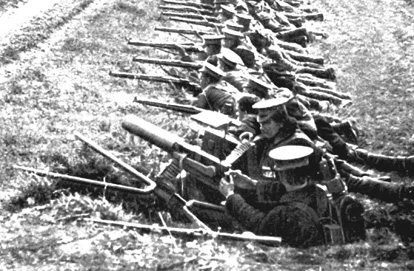

(top) British, Antwerp, 1914. (bottom) Russian, 1916. Heavy machine gun sections employed dozens of riflemen as helpers and defenders. They proved useful in the role of anti-aircraft marksmen. Source: (top) Baer C.H., Ed. Der Völkerkrieg (Stuttgart: Hoffmann, 1914) p.149; (bottom) Anon., The Times History of the War Volume 9 (London: The Times, 1916) p. 204
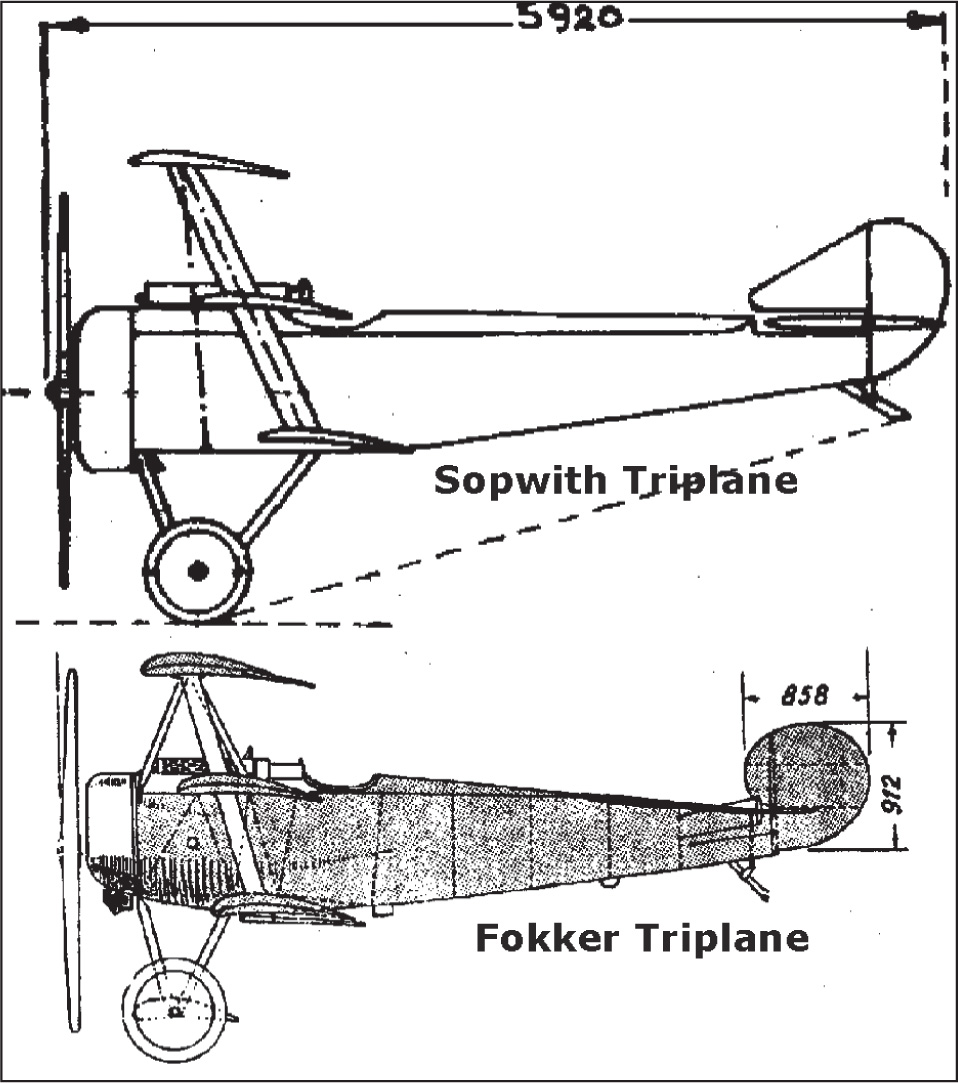
Wartime German illustrations pointed to the striking similarity between British and German three-winged aircraft; a factor leading to mistaken bullets from a confused infantry. Source: (top) Flugsport, February 1918, p.104; (bottom) Flugsport, July 1918, p.n/a
Each side shared in this curious belief. For example, German General von Hoeppner7 noted that his troops were convinced that “foes were marking their planes with German insignias.” As a result, many Germans fired at anything that flew. The similarity of many designs, for example British and German triplanes, fostered the notion. See sketch.
Americans were also caught up in this paranoid world, consisting of flight under false colors. Innocent victims included anti-balloon ace pilots Frank Luke and Joe Wehner. One day commander Harold. E. Hartney found them8 “heatedly discussing the thousands of bullets fired at them, from our side of the lines as they made their way home … it happened many times.” The mere flying of clearly and correctly marked aircraft wasn’t enough. To certain minds, all aircraft were potentially those of the enemy. For such men, flight at a low altitude itself was sensed as proof of evil intent.
Luke and Wehner, concerned with shooting down observation balloons floating at a negligible altitude, required the lowest possible route for approach and return. As given by Hartney, “you have to come down within 100 feet of the ground … [and face] 10 to 20 machine guns and countless rifles.” 9 Unfortunately, this was exactly the path assigned by the paranoids to their enemies. Hence the “thousands of rounds” – much of it rifle fire – offered up by American troops to their own aces.
At times a low altitude did indeed indicate harmful intent. British pilot Lieutenant Sholto Douglas,10 intent on destroying a vital railroad bridge near Cambrai, France and fearful of missing with his too light bombs (20 lbs. each) flew over at a height of only 130 feet, receiving “much rifle fire” and “12 to 15 hits on my machine.” He survived, for his aircraft surface area (BE2c) was large and the truly sensitive area small, but the lesson was clear. The light damage his bombs inflicted upon the train line reinforced the moral – avoid low altitudes – because the penalties were large and the payoff small.
Ground strafing didn’t permit evasive tactics, for successful attack required flight approaching ground level. The inevitable results were frequent hits from return fire and a certain cool judgement about receiving aircraft hits. To American Elliot Springs,11 conducting strafing runs “at a couple of hundred feet,” the finding of a “few holes scattered about the plane, but nothing serious” reflected a typical day’s effort. Again, the aircraft’s critical area was small, and not easily struck.
Other strafers were not as lucky. American Lieutenant Bill Lambert, ground strafing in SE5’s with members of his 48th Squadron in April 1918, saw six of their machines crash as a result of return fire.12 Yet, oddly enough, “none of our pilots was badly hurt … ” Chance and luck could be very picky. Or perhaps it was a matter of that truly tiny sensitive area – that of a man plus engine plus fuel and oil tanks, along with a few vital control points.
To British intellectuals reaching for some sense of certainty in the uncertain world of return fire, the figure for truly sensitive target area was usually taken to be 20 square feet. A hit anywhere in this sector was interpreted as a total loss – be it of man or aircraft. This number arose from the pre-war work of British engineer M. O’Gorman.13 To determine the likelihood of return fire hits, he arranged for a locomotive to tow a large box kite containing a marked 20 square feet of sensitive area, serving as a target. Test shooters included regular Army riflemen numbering as many as 48, or a single Vickers machine gun. In the course of many runs 1587 rifle bullets were fired, and there were eight sensitive area hits, or roughly one in 200. Next, an expert machine gunner fired some hundreds of rounds and achieved the same level of accuracy: roughly one critical area hit per 200 rounds fired. In sum, the tests showed that whether fired by a rifle or machine gun, bullets had about one chance in 200 of hitting a sensitive spot on a remote, moving kite serving as a mock aircraft.
Modern criticism of the O’Gorman test would feature two serious departures from reality – those of kite speed and range. Certainly the kite speed of roughly 25 mph was too low to simulate an aircraft, and served to ease the shooting task. On the other hand, the range employed was too great, by some hundreds of yards, greatly increasing the difficulty of the shooters. These failures to duplicate actual wartime shooting conditions prevent serious consideration of the O’Gorman ‘one in 200’ result. We suspect that his result reflects only the proper order of magnitude, i.e. ‘one downed per hundreds fired.’ However, whatever the exact ratio might have been, it was apparent that given enough rounds fired, there would be successful hits in sensitive areas and aircraft would be brought down. Furthermore, there was reason to believe that every rifle round fired was about as effective, per bullet, as one fired from a machine gun in terms of hitting a distant, moving target. What mattered in mass firing was the number of bullets fired, and not the weapon. At a time when machine guns were in short supply, the prospect of employing readily available rifleman as anti-aircraft defenders was most appealing.
Not only were riflemen present by the many thousands, but each had an easy flexibility of aim denied to many machine gunners. Early anti-aircraft machine gun mounts were notoriously poor, offering a limited capability for shifting one’s aim, or in other cases, inadequate stiffness of support, such that recoil force altered the aim of all rounds following upon the first. By comparison, the rifleman was more nearly in full control of his direction of fire at all times.
Anti-Aircraft Defense, German 1914.
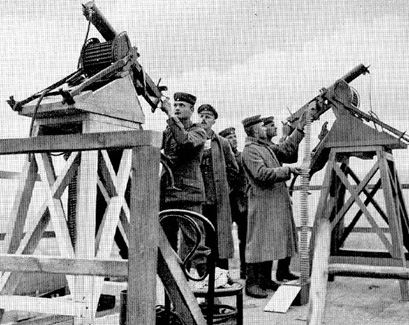
These early German machine gun mounts permitted changes in elevation, but not those of azimuth (left-right) – a serious defect. Any rifleman offered greater flexibility. Source: Baer, C.H. Der Völkerkrieg,(Stuttgart: Hoffmann, 1914) p.164.
Even so, the sources of his aiming errors were many. For one, it was necessary to know the aircraft speed and range in order to plan for the simultaneous arrival of plane and bullet. Should the aircraft pass over at a range of, let us say 600 feet, the usual rifle or machine gun bullet’s speed was such that roughly 1/3 of a second was required for the bullet to arrive. Moving at typical fighter combat speeds of 120 feet/second, the aircraft would move forward by some 40 feet in the course of this time delay. As a result, aiming directly at the aircraft was useless, for the bullet would pass 40 feet behind the aiming point. Instead, it was necessary to aim and shoot at empty space some 40 feet ahead of the aircraft; a distance larger than the length of most fuselages. While gun sights could be set to automatically supply this amount of deflection or “lead”, the correct value of offset depended on the range and the aircraft velocity, both of which had much to do with happenstance and were usually beyond the shooter’s ability to judge both quickly and accurately. As a result, the actual lead employed was generally a matter of split-second guess work, set into place as the aircraft passed over. Unhappily for riflemen, the loss of accuracy owing to mistaken lead allowance was serious.
There were yet other forms of major aiming error. Just as long range led to serious aircraft targeting errors, too short a range produced another form of aiming difficulty – that resulting from the need for pivoting the rifleman’s upper body to follow his fast moving target. A very short range required a fast and precise pivoting action; a physical stunt that few could perform properly. In the extreme case, given a range of 120 feet, and an aircraft speed of 120 feet per second, the necessary speed of pivot (roughly 52° per second) was so high that no man had the ability necessary to hold the enemy continuously in his sights, while smoothly pivoting. Thus, flight at an extremely short range, or low altitude, could well mean safety for aircraft passing over the front.
Why Shooting at Long Range is Difficult
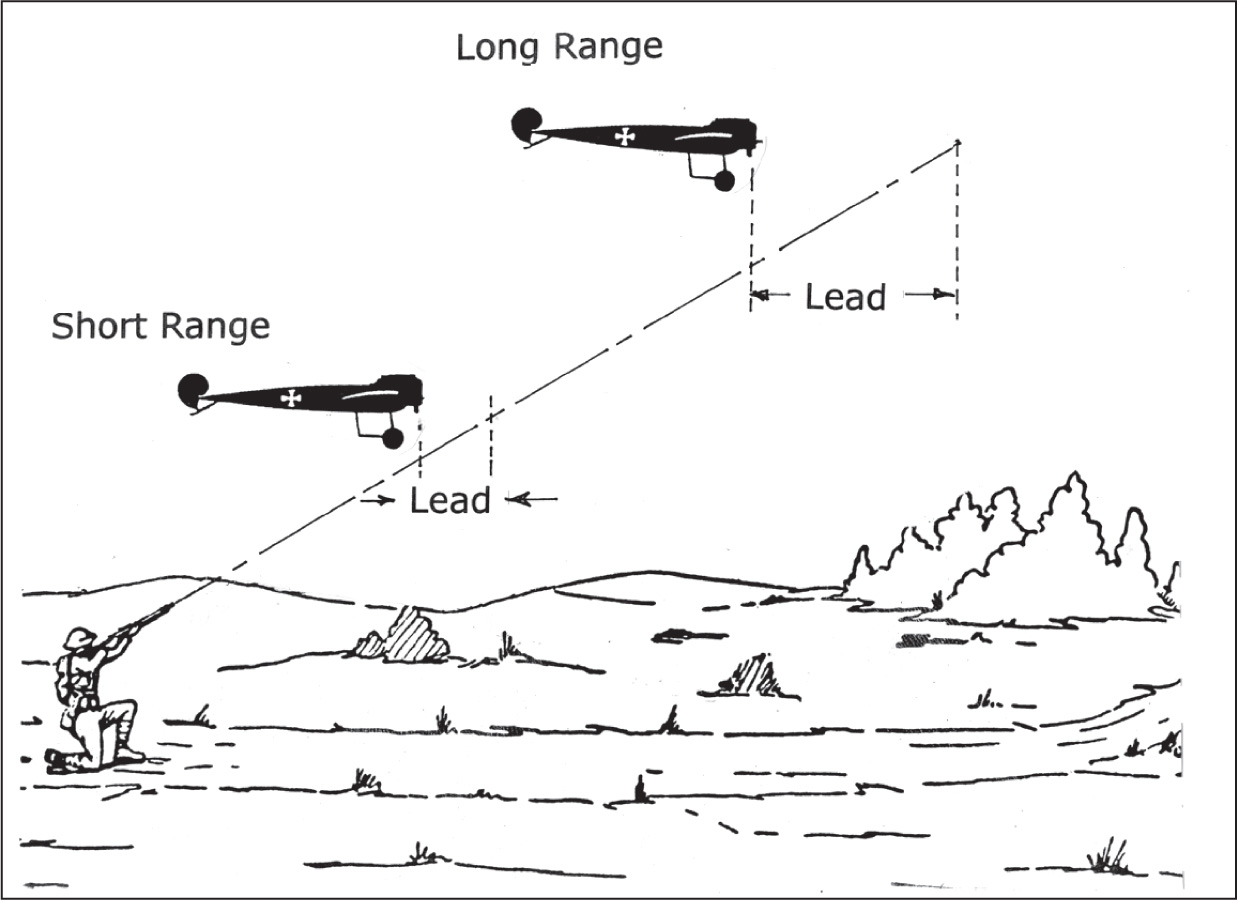
Lead, a certain distance aimed ahead of the aircraft, was required to permit the bullet to meet its target. As range increased, lead became huge, resulting in large errors in setting the right amount. In turn, accuracy vanished. Source: Original sketch by author.
Why Shooting at Short Range is Difficult
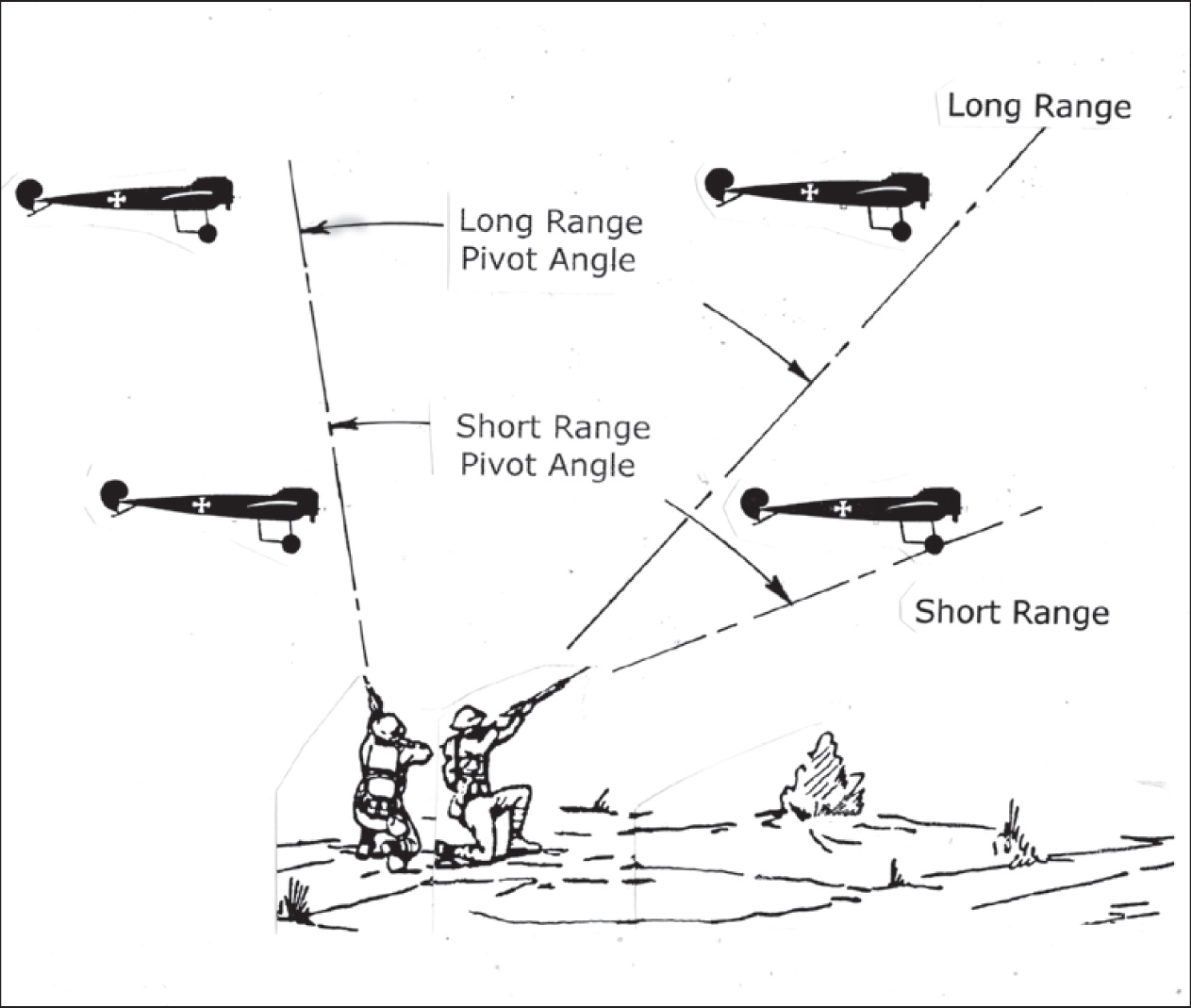
To keep the aircraft within his sights, it was necessary for the rifleman to pivot; the shorter the range, the faster the pivot. Few had fast pivoting ability. As a result, hits were unlikely at extremely short ranges. Source: Original sketch by author.
At longer ranges, the pivot problem faded. Men could master the smaller angle of pivot required and shooting accuracy improved. However, as noted, the value of lead increased with range, and with it the probable error owing to mistaken lead allowances. In sum, both extremely long and short ranges were clearly safer for aircraft. A rifleman’s best chance came with aircraft at a moderate range; neither too short for proper pivoting, nor too far for proper lead assessment.
Of all the possible ranges, fighter pilots would benefit most from knowledge of that altitude offering the rifleman his best chance – the most dangerous height for aircraft attacked from the ground – the one to be avoided by pilots at all costs. Was it in the low hundreds or high hundreds?
Mathematician A. Mallock14 tackled this problem in 1918. He found that its complexity forced the use of simplifications. For example, the range was taken as purely vertical; i.e., the aircraft was to pass directly over the shooter. The issue of range and range error was handled by assuming a standard plus or minus 3% error for all range estimates. At say, 200 feet of altitude, this amounts to an allowable error of plus or minus 6 feet. We believe that few men can judge altitude so precisely. The effect of the 3% assumption was to minimize that shooting error owing to range and lead. Furthermore, aircraft velocity was considered fixed at 100 mph, and the effect of speed variation or error was not considered.
The resulting most dangerous height was found to be “about 300 feet” and the probability of an ordinary rifleman hitting the standard 20 square feet of sensitive target area at this altitude was estimated to be about one chance in eight. The finding of 300 feet as most dangerous was roughly consistent with practical experience and so quite acceptable. However, the ‘one in eight’ odds seem disturbingly high. Author Mallock agreed, concluding his work by admitting that his “assumptions are too favorable to the gun.”15 We concur.
Inserting other assumptions about range error and velocity, in which the gunner was granted less accuracy in his estimates, would have resulted in a much lower probability of hitting the target. Such a lower value would have been more nearly in line with Rickenbacker’s ‘worse than one per hundred’ or O’Gorman’s ‘one per two hundred’. We know of no subsequent work exploring Mallock’s assumptions.
Also wanted was that number of riflemen necessary to assure destruction of an overflying aircraft. From the theoretical point of view, calculating this number required more than knowing the odds of getting a hit in a sensitive spot. An extra computing step was necessary.16 For example, let’s assume the odds of destruction are ‘one per hundred.’ It would be wrong to conclude that employing 100 shooters would assure destruction. This case falls into that branch of probability theory dealing with ‘independent events’. If given a hundred shooters, each with a 1% chance of bringing down their target, the proper expression for the probability of destruction is: {1 – (.99)100 }. The resulting 63% probability value strongly suggests destruction, but doesn’t guarantee it; there is still a better than 1/3 chance that the enemy would survive. To be fairly certain about destruction, let’s say 95% certain, many more than 100 shooters were required. Infantry officers, seeking practical answers to the number of riflemen necessary to shoot down aircraft, pooled their experience in the form of how-to-manuals. A set of official German instructions, issued in September 1917, offered this solid advice:17
Fire from single rifles is useless. Only the concentrated fire of 80 to 100 rifles can lead to success. Fire control, quick decision on the part of the commander, good fire discipline and rapid delivery are necessary.
These views were a good fit to probability theory predictions, and also met the test of combat reality. Masses of riflemen, properly handled, could indeed bring down overflying aircraft. As for single shooters, no matter how skilled, experience showed they were most unlikely to achieve significant destruction.
Army manuals offered practical aiming advice as well. In some cases, this advice was useful for pilots as a guide to that which was best avoided. For example, aircraft crossing the frontlines at a right angle were noted18 as more likely to be shot down than those moving along a trajectory inclined to the frontlines. This had to with the rifleman’s difficulty in predicting the future flight path of his target. Given only an oblique view of a distant aircraft, to spell out the resulting angular trajectory was not easy. Consider this problem in detail.
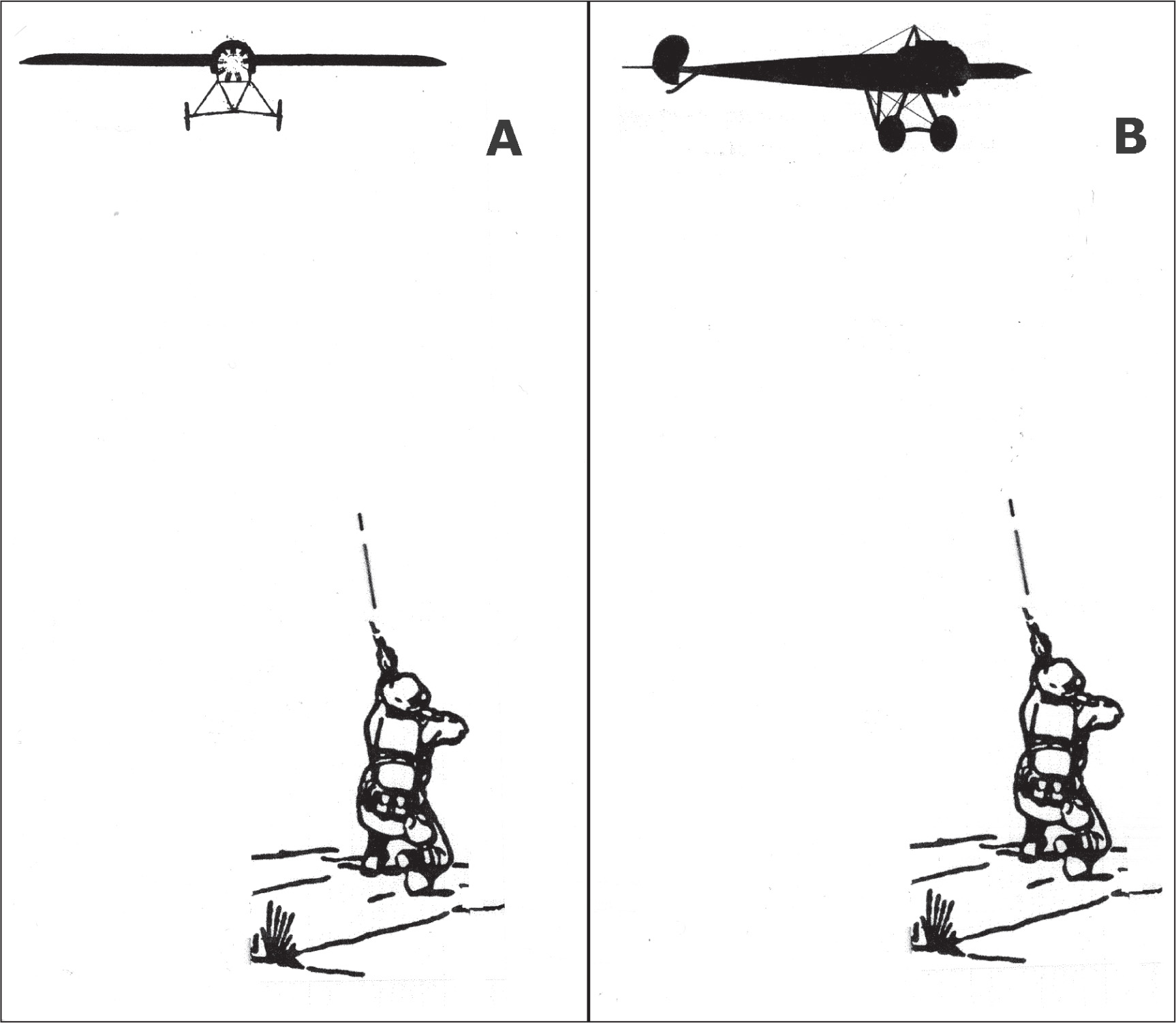
Crossing at an angle (B) other than a right angle (A) made for trajectory and lead uncertainty, lowering the rifleman’s chances. See text. Source: Original sketch by author.
When crossing at right angles, as shown in (A), the future path was obvious. When moving at a slant to the front as in (B), determination of the angle and future path was far from obvious. Furthermore, a devious pilot could hold his machine at say, 10° of yaw with respect to his flight path. As a result, even a perfect knowledge of the machine’s angle with respect to the shooter could prove of little value in determining future trajectory. Yet future trajectory, to be judged within seconds, was a key step in the aiming process. As a result, (B) proved to be the wiser path for pilots when crossing frontlines.
To many pilots it seemed that crossing at a high altitude, out of small arms reach, was the best move. However, fresh problems arose as altitude increased. For one, anti-aircraft cannons tended to become effective at higher altitudes – 1000 meters or more – and secondly, flying at great values of range hampered vision and prevented good reconnaissance. Experience showed that precise spotting of the fall of shells required the use of low altitudes and much line crossing. When so engaged, the artillery spotter offered great incentive to the rifleman, for the struggle sometimes amounted to a personal duel.
To aid the rifleman, simple, quick solutions were offered to the vexing problem of lead; solutions doing away with reflection and computations. As a German Army example:19
Extreme Range and Gravity Lead
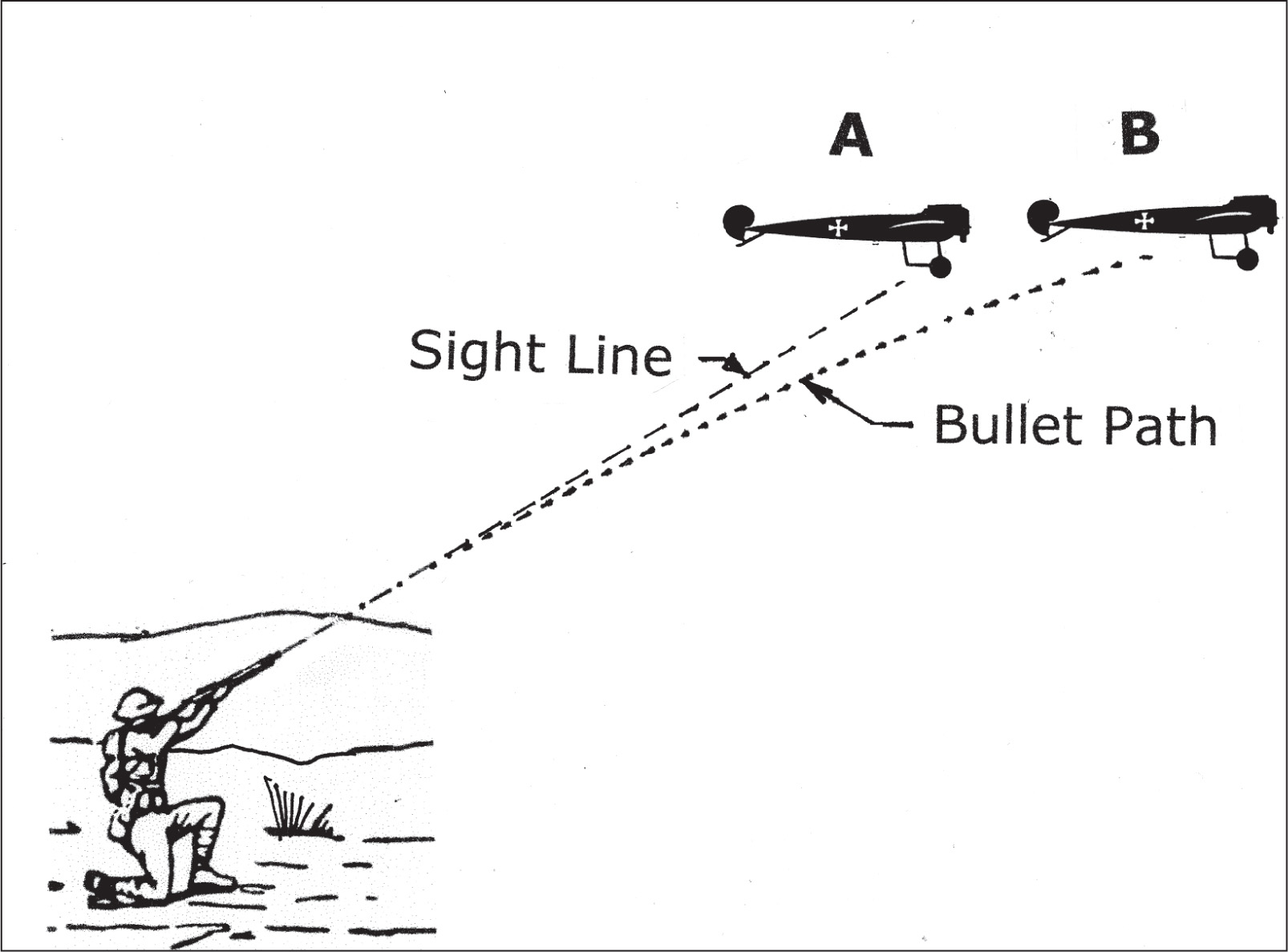
At extreme range, aiming directly at the aircraft (A) could supply adequate lead, by means of bullet drop caused by gravity, yielding a hit, as at (B). Source: Original sketch by author.
When the aeroplane is flying away, aim will be taken below the aeroplane, up to a range of 1000 meters, and directly at it above that range. (italics sic.)
The wisdom of the ‘aim below’ suggestion is evident upon checking those prior illustrations concerned with lead. To aim below a departing aircraft was to aim ahead of the machine. Properly done, and given a reasonably short range, the bullet caught up to the aircraft.
The second suggestion – aiming directly at the aircraft – makes use of the bullet’s drop in height, that resulting from gravity. At extreme ranges, requiring several seconds of bullet travel, the drop was a matter of many feet. The effect was to bend the bullet path downward, as it moved forward.
Despite their basic merit, both these suggestions suffered from a lack of detail. For example, aiming below departing aircraft at short ranges, though correct in principle: yes, but how much below? Not only was the precise amount all-important, but the answer varied with range and speed. To incorporate these factors, the rifleman needed much more advice. In sum, what was offered fell far short of practical application. Similarly, aiming directly at a departing aircraft, positioned at a great range, was a sound notion. However when at great range, half a mile or more, many other factors influenced the outcome: such as the rifleman’s stability, visibility, and ability to predict the aircraft’s future path. As a result, for most shooters the likelihood of a hit at extreme range was very low – even when shooting against a fixed target. Finally, there remained the unresolved issue of how one located the transition point for aim – given as 1000 meters distant. Ordinary gunsights were of little use and there was no easy answer. Once again, the advice offered was seriously inadequate.
Why give soldiers advice of dubious value? Perhaps the object was to encourage riflemen to shoot, even if their individual chances were negligible. Bullets were cheap and there was much logic behind mass fire as a means of achieving the desired destruction through sheer numbers.
Competing anti-aircraft service cannons, working at their best altitudes, offered a sense of the extreme difficulty found in achieving proper aim. Over the entire war,20 the French fired an average of 3225 shells to destroy each of those aircraft downed. The corresponding British figure was one downed per 1800 fired, and that of the Americans, 1055. The inferior French figure represented years of learning how, while the superior American values reflected both late entry and use of the latest French arms. Taking as the average, an Allied order of magnitude figure of ‘one downed per thousands fired’, offers us a means of comparing the success of cannons, as against rifles. Summing up all considerations, the order of magnitude of the rifle success ratio was probably ‘one downed per many hundreds fired’. Therefore the rifleman’s expenditure of bullets in downing aircraft was no less effective, per aircraft downed, than the firing of shells, and quite possibly more effective. Certainly rifle fire was much cheaper.
However, the rifle’s reach was extremely limited as compared to that of the cannon – at times, an overwhelming disadvantage. Still, there was considerable logic to deploying riflemen as an anti-aircraft auxiliary. Accomplishing more than the bringing down of enemy aircraft, the threat of the rifleman itself served to alter tactics over the front.
For example, Flt. Lieutenant R. M. Foster’s wartime experience21 detailed the acceptance of mass fire effectiveness, along with its tactical implications. He first noted the changes wrought by infantry units with “their rifles and guns at the ready – sufficiently concentrated to produce that volume of fire which, by the law of averages, brings about the lucky hit.”
As a result, he would restrain the employment of low flying aircraft over the enemy’s established defenses, using such flights “as little as possible.” Instead, he would employ strafing in periods of “moving [i.e., mobile] warfare … [when] … the employment of low-flying aircraft in large numbers will amply justify the losses sustained.” In other words, aircraft losses arising when flying low over established infantry units were large indeed, so large as to be acceptable only when crucial to the success of a big push.
Given this desirable condition – a mobile frontline – how should one go about strafing? As given by Foster, safest was never to climb above 50 feet of altitude. However, this altitude led to great difficulty in selecting targets, for when flying extremely low, targets flashed by before action could be taken. One effective compromise was to initially fly over at an altitude beyond small arms range, selecting targets at about 2500 feet, and then to dive down to less than 50 feet for the actual strafing run. Regaining height was sensed as a mistake: it offered one’s profile for every shooter below and took too long. Simply returning home was much better, when done at that most desirable altitude of 50 feet or less.
Foster’s views were prevalent, for they offered much in the way of universally shared experience and common sense. In sum, the rifleman, when in massive numbers, was a menace to all low flying aircraft. Fifty feet up was the only safe height for crossing over the lines. At more than one hundred feet of altitude, major troubles were anticipated from riflemen; troubles not to cease until a few thousand feet were gained.

What of Richthofen, and his end? Did death by rifleman fit the facts of his case? Despite the confusion and contradictions surrounding his death, certain useful data and claims do exist. Examination with the tools of engineering permits us to separate fact from fantasy, thus spotting mistaken or lying claims and allowing for the entrance of logic. We end, still unsure of Richthofen’s killer, but relieved of much burdensome nonsense and with an improved sense of the odds favoring each claimant.
Consider Richthofen’s flight path on the fatal day.22 As leader of Jasta 5, he flew as part of a loose formation, that of fighter groups Jasta 5 joined to Jasta 11, guarding a number of observation machines, totaling roughly 20 aircraft in all. While still on the German side of the lines, and moving towards Australian-held territory, they met approximately a dozen British machines somewhere between Cerisy and le Hamel. These included the Camels of ace fighter pilot Captain Roy Brown (12 victories) and beginner Lieutenant Wilfred May. The latter had been given sound advice: he was to observe, rather than participate. If somehow caught up in fighting, he was to drop to the 50 feet of altitude recommended by Foster and streak for home.
As the melée developed, May was singled out by Richthofen as his next victim. Realizing that he had become a target, May followed instructions and speeded towards the Australian lines, though not at 50 feet of altitude. Instead, he flew at a height in the low hundreds – an exactly wrong, but understandable error – for the terrain was hilly and overgrown with trees. Richthofen followed, determined to blast May’s Camel.
In the midst of combat, Brown looked down and saw May under close pursuit, and clearly in trouble. Concerned with saving May, he attacked the pursuing all red triplane, employing a single shooting pass at roughly right angles to the triplane’s path. Brown’s review of the encounter23 placed the combatants “at not more than 200 feet above the ground and directly over the Australian first line trenches.” He saw infantrymen staring at the intruding aircraft, with machine gunners shooting at the “red plane.” He next saw Richthofen’s machine “waver and fall to the ground between the first line and the support trenches of the Australian infantry.” Brown turned away, convinced that though many below had fired, he personally had ended Richthofen’s threat. However, a number of observers disagreed.
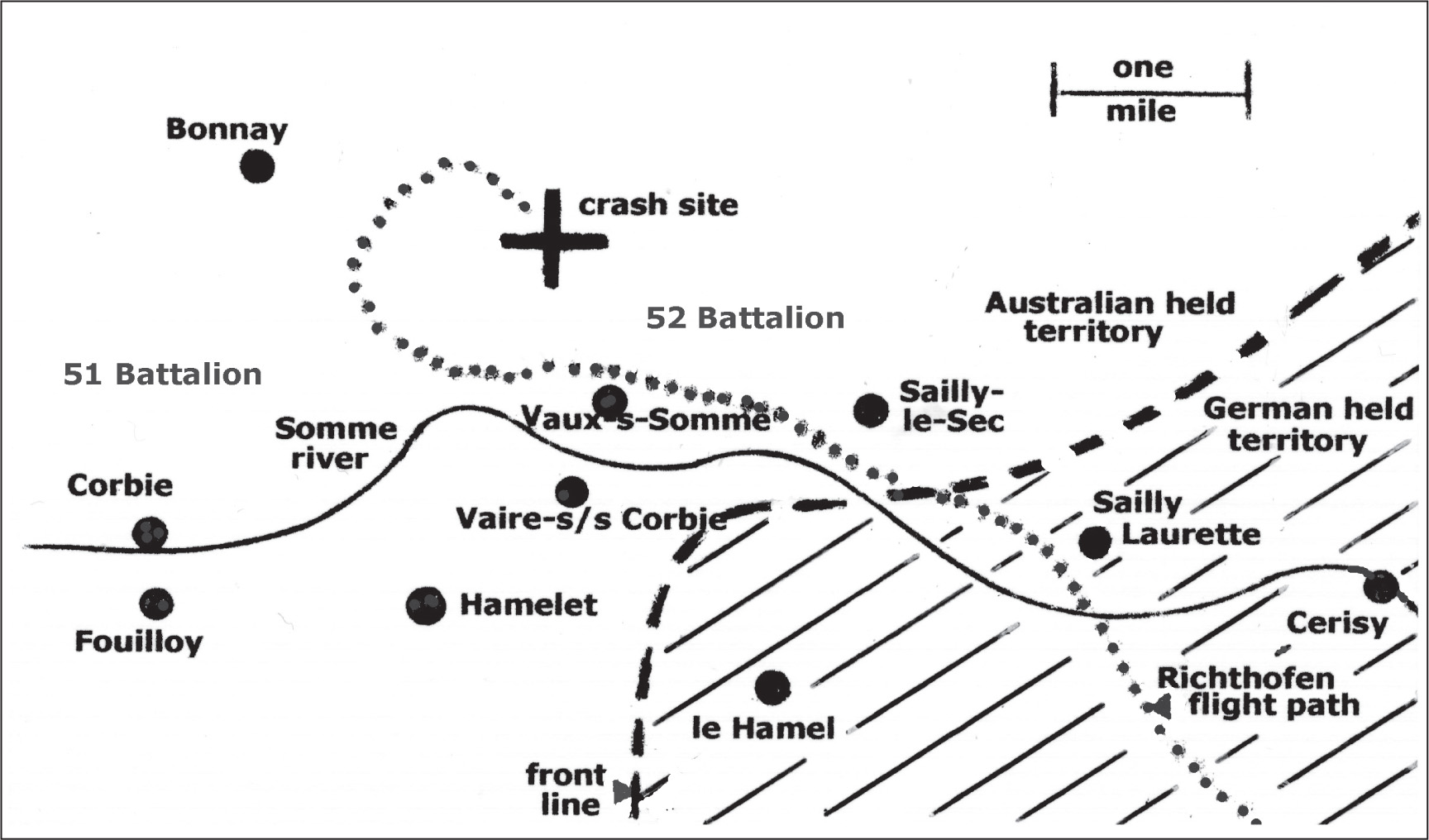
Crossing over German held area into unfriendly territory, he encountered British fighters and Australian ground fire. Somewhere along the path shown, he was hit and killed by a single bullet.Source: Original sketch by author, guided by old auto maps.
For one thing, the location of the downed red triplane as given by Brown, was roughly two miles distant from its actual resting place (see map). Perhaps the error reflected only a post-combat lapse in judgement concerning a detail, but it was an important detail, for if Richthofen had flown on for some appreciable distance after Brown’s attack, it was possible that someone else had brought him down. Secondly, Brown himself made a poor witness, for he was clearly disturbed and in the early stages of a nervous breakdown; a man who readily admitted to living exclusively on a diet of milk and brandy.24 The contrast between the lifestyles of the two men produced doubt that Brown could possibly have won a mortal duel against Richthofen. Finally, despite claims of word-for-word authenticity and official acceptance of his detailed story, obtained through interview, as part of RAF history, certain sentences were prepared in too writerly a fashion to be acceptable as Brown’s actual words – for example, the description of his Camel aircraft after that day’s fighting as: “a sorry sight with twisted wires and punctuated wings … with only two cylinders working.”25 The voice heard was not that of a combat pilot, but that of a journalist. Inevitably, doubts have arisen concerning the authenticity of Brown’s story.
Within a few more days he succumbed to the nervous disorder that had been plaguing him for many weeks, and was invalided out of frontline service. Still, whatever the doubts surrounding Brown, it is accepted that he did fire a short burst at Richthofen and therefore may have been entitled to his victory claim.
May’s basic route had been towards Bonnay. After Brown moved off, he continued along this path, leading the still pursuing Richthofen over the guns of two Australian anti-aircraft battalions. These were equipped with a mixture of Lewis and Vickers machine guns, plus the rifles of hundreds of riflemen.
Sergeant C.B. Popkin of the 24th Australian Machine Gun Company was a Vickers gunner emplaced south of Bonnay. Pure luck positioned his gun along the path of May and Richthofen. They approached at high-speed, flying at an ideal height of “about 200 feet from the ground.” Carefully avoiding the targeting of May’s aircraft, Popkin opened fire on the red triplane26 positioned “perhaps 100 to 120 yards in front of me” and flying directly towards his gun. He fired for “30 to 40 seconds.” Within this time, he claimed the firing of 80 rounds directed at Richthofen.27 As his target circled away, Popkin had a fresh opportunity and claimed to have fired again, for about the same amount of time. If his sense of that time spent shooting was correct, the total period claimed was sufficient to have fired well over 150 rounds. He then saw Richthofen’s machine stagger and crash. Understandably, he concluded that his bullets had downed the red triplane.
As with Brown, there are problems with Popkin’s story. Moving directly towards Popkin at combat speeds of 120 feet per second (82 mph) or more, one would expect Richthofen to have overflown the claimed intervening distance of 120 yards in roughly 3 seconds. How Popkin managed to fire effectively for a claimed “30 to 40 seconds” in the course of a 3 second straight line approach period is far from clear. We suspect that Popkin was seriously mistaken in his time and bullet estimates. In sum, we believe that he overstated his period of fire by a factor of 10 fold, and that the true number of bullets fired effectively were relatively few. For a corrected figure, we shall use the official Vickers figure for rapid fire: some 250 rounds28 per minute. The resulting number for 3 seconds of firing: 12 rounds.
Regarding Richthofen’s subsequent circling maneuver and Popkin’s second firing opportunity, the path and distance numbers necessary to check the results have never been available. As a result, the prospects of Popkin’s second chance remain unexamined. It is likely that as before, a dozen bullets were fired. However, it is accepted that Popkin did indeed fire at Richthofen, who then crashed, mortally wounded, some time after Popkin’s second firing run.
One more claimant for the role of Richthoften’s killer was Sergeant Robert Buie of the 14th Australian Field Artillery Brigade. Working one of the two post-mounted Lewis machine guns assigned to the 53 Battery, he found himself in position to shoot just as May and his pursuer hurtled by. His alignment with respect to the aircraft was similar to that of Popkin: both aircraft were on a nearly head-on path, one behind the other, and inclined slightly to one side.
Buie claimed that he opened fire at 200 yards and kept shooting until “my last shots finished at a range of 40 yards.”29 Applying a straight line aircraft flight speed value of 120 feet per second (82 mph) to the distance of 160 yards (i.e., 200 minus 40), yields an elapsed time result of 4 seconds. Buie claimed to have carefully aimed and fired off the entire drum (47 rounds) in careful bursts, all within this 4 second time period.
His first 20 rounds were spent in registering the target, with Richthofen moving straight ahead and slightly towards the right of his position. May’s aircraft location, a bare 60 feet ahead of the red triplane, was a major problem. To shoot at the rear aircraft, without hitting the one out in front was far from easy. Yet Buie claimed to have done so, and also to have noted changes in Richthofen’s posture as he hunched down behind his twin Spandau machine guns30 to fire at May’s aircraft. He also claimed to have noted a “sharp change in engine sound” signifying the stoppage of Richthofen’s engine, an event suggesting that Buie’s bullets were well-aimed. Richthofen then moved into a low altitude glide, finally hitting the ground in a crash landing.
As with Popkin and Brown, there are difficulties of belief. Firing off a full drum of Lewis gun bullets in careful bursts, so as to avoid hitting May, while noting Richthofen’s position within his cockpit, etc., and all done within 4 seconds, seems unlikely. Even the official maximum cyclic firing rate31 of the Lewis gun, given as 500 to 600 unaimed rounds per minute, does not aid the Buie claim. In reality, his firing rate would have been much lower, forced down by necessary pauses. Some were made necessary by cooling requirements; i.e. a short halt after the firing of each 6 to 10 bullet burst.32 Additional pauses were necessary to re-aim the gun at Buie’s tricky target, trailing behind May’s aircraft, and as such, partly hidden. With pauses forcing a much lower time-averaged firing rate, many more than 4 seconds were required to empty a full drum. In sum, constraints upon firing rate suggest strongly that Buie didn’t fire a full drum at Richthofen. We do believe that Buie did fire some rounds at Richthofen – likely far fewer than a dozen bullets in all – preceding Richthofen’s crash. However, the connection between bullets and crash, if any, remains unclear.
The difficulties with belief noted above in connection with the stories of Richthofen protagonists Brown, Popkin and Buie suggest a search of other eyewitness reports. There were other such reports, by British airmen and Australian ground troops. RFC/RAF pilots routinely submitted a combat report listing claims and, where possible, the names of eyewitnesses. Thus, in concluding his description of the Richthofen encounter,33 Brown stated: “I got a long burst into him [Richthofen] and he went down vertical and was observed to crash by Lieutenant Mellersh and Lieutenant May.”
Eyewitness Lieutenant F.J.W. Mellersh’s own report34 noted: “… a red triplane crashed quite close to me and as I looked up I saw Captain Brown’s machine.” However, mere presence on the scene wasn’t equivalent to shooting down an enemy aircraft. Even if the triplane did in truth crash in the presence of Brown, and there were dozens of ground-based viewers who did not agree, Mellersh’s statement failed to confirm a victory for Brown.
Lieutenant May was far more positive.35 “While he [Richthofen] was on my tail, Captain Brown attacked and shot it down. I observed it crash to the ground.” Surely no witness was better placed, or had more at stake in Richthofen’s crash than May. Yet, a great many Australians saw no such thing. A shooting pass by Brown, yes; but the only immediate result was Brown’s departure, after which Richthofen’s pursuit of May continued for several miles. During the pursuit, following much shooting from the ground, May was able to escape and Richthofen was finally brought down at a spot remote from May’s path. In sum, May couldn’t possibly have seen Richthofen “crash to the ground” immediately after Brown’s attack, for the good reason that it didn’t happen at that time. This negative view, taken from the reports of many dozens of Australians,36 is unlikely to be mistaken. In weighing the truth of evidence, numbers count.
It’s the evidence of single witnesses that tends to prove troublesome. Not only have the odd views of May and Mellersh produced doubt, but as shown above, those of the individual claimants Brown, Popkins and Buie were also unconvincing. Unfortunately, this has also proved to be the case with reports of presumably disinterested observers. For an example, consider the evidence submitted by Lieut G.M. Travers of the 52nd Battalion.
Equipped with field glasses, and assigned the task of observer, he seemed well suited for the task. Choosing a spot near Popkin’s Vickers gun, he was in a perfect position to see Popkin’s attack as May and Richthofen swept by. His eyes convinced him of Popkin’s success in shooting down the pursuing red aircraft: “the enemy plane [Richthofen] swerved to the right so suddenly … ” as to suggest a serious hit. After the crash he “had a look … at the driver who was dead, a machine gun bullet had passed from the left side of his face and near the bottom of his jaw and came out just behind his right eye.”37
However, there was no such wound. Autopsies conducted by two medical teams pointed to only one serious wound, at heart level.38 A single bullet had entered his torso at the right arm pit, and exited at the left nipple. There has never been a question about the location of the single, fatal wound. Travers, with his strange, totally mistaken story, proved himself inept in the role of observer. The practical effect of his tale was to greatly reduce the value of his support for Popkin as the killer of Richthofen.
Yet another witness of this type was Sergeant H. Hart, 53 Battery. Hart was in position to see Buie fire, after which “splinters flew from it [the red triplane] and it veered … and crashed about 500 yards from the battery.”39 Rushing over to inspect the corpse, he saw “ … the wounds, they were frontal, in the chest, abdomen and legs – all in the front … ”
Once again, the medical autopsies did not agree. In addition to the death-dealing single bullet wound, the body did exhibit other wounds including “minor bruises” and a broken jaw caused by the crash, but these were not pertinent to Richthofen’s death. What might have been strong evidence by Hart faded under the influence of his mistaken observations.
In sum, the eyewitness evidence offered by Brown, May, Popkins, Buie, Mellersh, Travers, and Hart was all seriously flawed. Certain mistaken trends were evident. One such concerned the number of bullets fired; a number always exaggerated by those who reported on the shooting itself. A second error was in the number of serious, death-dealing wounds reported as sustained by Richthofen; a number always given as higher than the true value: exactly one.
Errors of excessive bullets and wounds served to back the concept of a machine gun as the weapon employed. In popular thinking, machine guns spew out bullets, and so a great many must have been fired. With so many fired, if well-aimed, numerous hits must have occurred. The existence of a single bullet wound was disturbing to this way of thought, for a single bullet strike suggests a rifle and not a machine gun. Was it indeed possible to shoot at a man-sized target with a well placed machine gun at a reasonable range and miss with every bullet – except one? If almost all the machine gun bullets managed to miss, why the exception?
The answer has to do with the scatter and spread of the emerging bullets. Each bullet had slightly different dimensions, and came with a slightly different amount of gunpowder, leading to correspondingly changed natural paths. Then, machine gun barrels whipped, and recoil vibration changed aim a bit. Over long ranges, the difference in path caused by these factors could be considerable. However, given a short range, if firing a full burst right on target, hitting a man with only one bullet was unlikely. Consider the implications of scatter result test data when applied to the death of Richthofen – a death caused by a single bullet.
Tests of new Lewis guns, bolted down securely, yielded a tight group of bullets. Firing results40 showed “all the shots falling within a [one] foot circle at 300 yards [range].” Noting that the range used in shooting at Richthofen was a good deal less than 300 yards, and that scatter decreases in a straight line fashion with range, we calculate a total scatter diameter of less than 8 inches at 200 yards. At this range, well-aimed test guns, bolted down to a rigid framework, and firing a full burst, were most unlikely to hit a man with only one bullet. If one bullet struck an armpit, many of the others were likely to strike his body as well.
Machine Gun Scatter (not to scale)
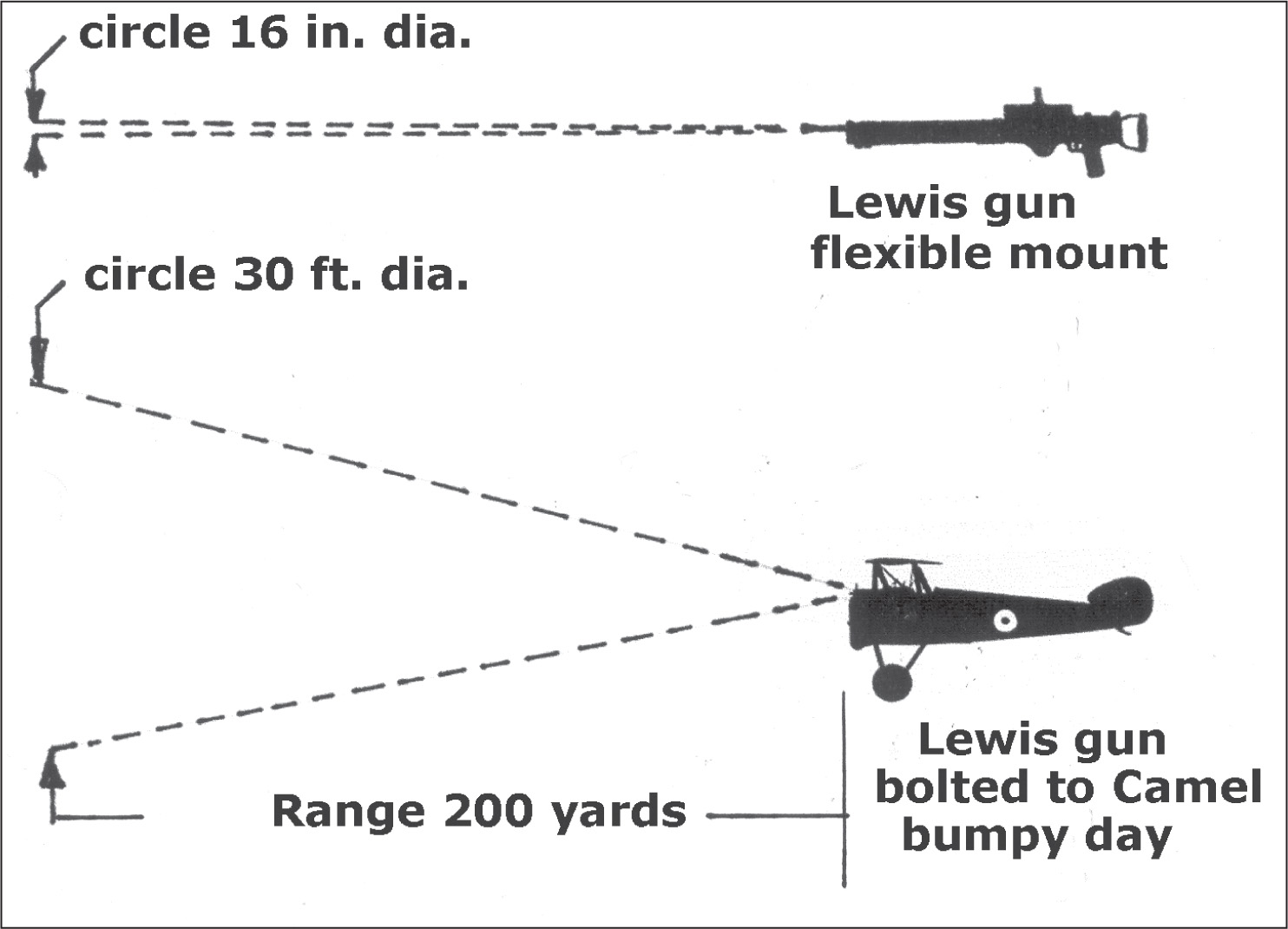
Richthofen’s single fatal wound suggests a high scatter source, likely that of multiple rifles or an airborne machine gun, rather than a well-aimed, ground-based machine gun. Source: Original sketches by author.
However, in reality the ground placed guns of Buie and Popkins were not rigidly held. They were flexibly mounted to permit following a target. Orfordness tests with a moving gun as compared to a fixed gun, showed the dispersion diameter to roughly double; i.e., we might expect a scatter diameter of about 16 inches at 200 yards. Into this area would pour some 70 to 80% of the bullets fired. The remaining bullets, considered “wild” rounds, might go far afield.
The effect of the change in mounting was to lower the probability of multiple strikes. Applying these findings to the cases of Buie and Popkin, and as before assuming that each gunner fired a well-aimed full burst, we would still expect several bullets to strike Richthofen. However, in reality there was no second wound, and we must conclude that in all probability, Buie and Popkin fired poorly aimed bursts. If one of their bullets did strike Richthofen, it could only have been a wild round. As for the bulk of their bullets, they went elsewhere.
Brown’s bullets were also subject to scatter. Even when fighter plane guns were fixed and bolted down, as were those of Brown, their bullets experienced a greatly increased spread owing to the lack of rigidity of the aircraft structure and the softness of air support. The bumpiness of the day’s weather was also a factor, acting to further increase the spread. Tests pointed to spread circles as large as 5 feet in diameter being necessary to contain ¾ of the Lewis gun bullets fired from a light aircraft at 250 yards range, on a calm day.41 Correcting for range, at 200 yards we would expect a scatter diameter of 48 inches, or three times that experienced by comparable ground gunners. On a bumpy day, and April 21 has been described as “gusty” and “turbulent”42, the scatter diameter could increase to more than 30 feet. So great a scatter meant that even a well-aimed burst by Brown was unlikely to hit Richthofen with more than one bullet. In sum, the single bullet strike is consistent with Brown’s having fired a well-aimed burst of bullets. Two hits by Brown defies probability, and even one hit suggests much luck.
As concerns riflemen, there were many hundreds of potential shooters, starting from within German held territory and moving to the final crash landing site. Large numbers of Australian riflemen were attached to the anti-aircraft service and charged with adding their fire when possible. As an example, one section of the 22nd Battalion, located in a similar area, and employing Lewis guns mounted on posts in the Buie manner, used at least 21 soldiers to man its twin Lewis guns.43 There were many such guns and many dozens of such potential riflemen. While the number of riflemen firing at Richthofen is unknown, it may easily have reached that “80 to 100” level required for success – the number specified by the German Army.
We would not expect a tight circle of scatter from the riflemen. With the target at about 200 feet of altitude and moving at high-speed, both pivoting and lead errors would be considerable, resulting in a large dispersion of those bullets fired. Even Brown’s estimated dispersion circle of 30 feet or more was likely too small to contain the riflemen’s bullets.
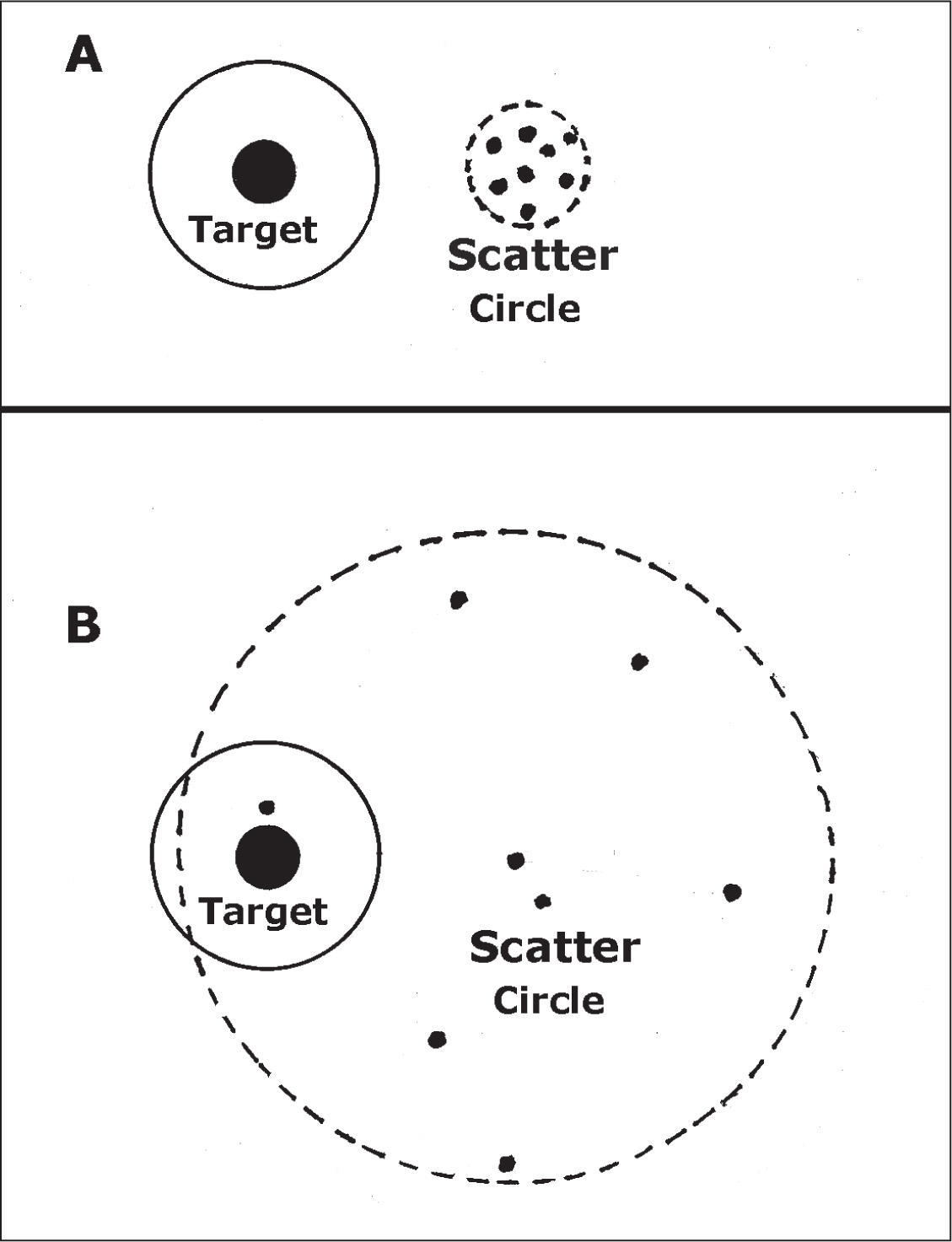
(A) A poorly aimed burst, fired with a small scatter, will miss the target with every bullet. (B) The same poorly aimed burst, fired with large scatter, may place a bullet on target through sheer chance. Source: Original sketch by author.
Still, there was an advantage to wide dispersion. At times, imperfect aim could be offset. Unlike a perfect, zero scatter gun, whose bullets went only where aimed, a mass of riflemen had the advantage of large scatter, possibly hitting the target despite poor aim. As shown above, a large scatter was capable of compensating for even dreadful aim – if enough bullets were fired.
Were there enough? Everything rests on the number of shooters. If a hundred or more men were able to get off two rounds apiece, they had a good chance of hitting Richthofen with a single bullet. In ignorance of the number of shooters, any prediction of the likelihood of success is impossible. It can only be said that the rifleman prospect is real and deserves consideration, not as an afterthought, but as a main contending possibility.

And so we conclude our study of Richthofen’s death; one concentrated on gunnery and chance. Though none of the “usual suspects” have been eliminated in our study, something has been achieved by identifying the mistaken eyewitness accounts and false logic that dominate this area. We next deal with an even stranger result of defective official reasoning: proof that air war itself was impossible.